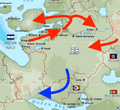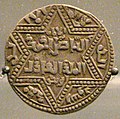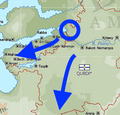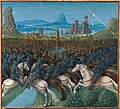Talk:Qubdi
Jump to navigation
Jump to search
Geography
Proposed additions for User:Tagmatium to review.
- Along the western coast of Qubdi stood Port Naucratis, a city of great importance. It was a melting pot of cultures, with people hailing from every corner of the globe - Occidental merchants, Shakyan gurus, Orinese pharmacists. The city was home to some of the oldest universities of the Christian world.
- The northern region of $regionName was a place of unique development, having been a colony for many years. The main cities bore the mark of Aroman influence, and the old dialect can still be heard in places like Kashromi.
Both cities mentioned here are already part of the main Qubdi article, and also located in the area in question. -- Orioni (talk) 12:49, 16 December 2022 (UTC)
History
Before making these suggestions, I reviewed the entire existing regional history. This includes the neighbouring countries. For maximum transparency, I will share all those findings.
- Sporsia history contains relevant information: Disorder (868-892), Qubdian rule (873-1001).
- Octarchy history doesn't go beyond 294.
- Gangrid Empire history doesn't go beyond 294.
- Aroman Empire history doesn't go beyond 350.
- Tagmatium history doesn't go beyond 821.
- Feluga history begins in 1623.
- Euandria history begins in 1864.
- Bashan history begins in 1908.
- Adaptus history only includes Occidental affairs.
- Suverina history is empty.
- Red Iberos history is empty.
- Bergenaria history is empty.
As you can see, the lore has a hole. More than a millennium's worth of history, between 800 and 1800. What follows are some ideas of what might have taken place. While reviewing this, it's been to keep an eye on the map of Qubdi and the wider region.
- 600s — In the 620s the Qubdians learned about the spread of Salam in Memopotamia. In 630, Nabi Hanan led the Salamids into southern Qubdi, making significant gains and spreading his faith among some nomadic !Berbes tribes. The Qubdians made preparations to crush the dangerous heresy. In 641 at the battle of $place, some 30,000 Muslims and 50,000 Qubdian troops clashed. The battle led to a massacre on both sides, and ended in a Pyrrhic victory for the defenders. The capture and imprisonment of Nabi Hanan shocked the entire Memopotamian Peninsula.[a] Many recently converted !Berber tribes reverted to their previous faith. [b]
- 700s — For the entire 7th century, the Qubdianas expanded their reach along Haken Bay. They clashed with the remaining Salamid forces in Memopotamia. During this southern war, the Great $BashanProvince revolt of 711 started. The rich $nobleHouse1 that ruled $BashanProvince supported the revolt, and cut ties with Qubdi.[c] More provinces followed soon after. This was a massive blow to Qubdian influence in the Amnalos Sea. $nobleHouse1 invaded the entire $peninsulaName,[d] supporter by the local population. They defeated the Qubdian army in the battle of Beth Haron[e] in 713 and occupied Port Naucratis in December of the same year. At the same time, the !CentralAmutians conquered $easternProvince.[f] Two years after constant conflict with the Tagmatines and the conquest of $peninsulaName, the $nobleHouse1 conquered the capital city of Itjtawy in 715. This country now became known as the $nobleHouse1 Empire. Their expansions along the Aroman-Amutian frontier, where they only vassalized the local kingdoms. For the next century, the $nobleHouse1 had their capital in Naucratis and promoted the $BashanProvince rite, a situation that didn't please the Church of Itjtawy.
- 800s — This religious problem was used by general $personName1 to lead a revolt in 823. Supported by the local population, he established the independent Kingdom of Itjtawy. During its first years, the kingdom was stable. But $personName's successor tried to gain control over the church. This produced instability in the kingdom. $nobleHouse1 saw chance to retake Itjtawy and fought against the weakened kingdom, reconquering it in 848. However, the $nobleHouse1 king died without successor. This led to a civil war, and a revolt of the Yuropan mercenaries that ruled Qubdi for the next 65 years.
- 900s — In 913, the Yuropans were defeated by a General of Aroman origin. That was the beginning of the $nobleHouse2 dynasty. What followed was a long period of stable rule in Qubdi.[g]
- 1000s — This peace lasted until the year 1001, when Marzban Abundantiu of Tzius killed king $personName2, after the Qubdi defeat against the Aexpurtias. The Aexpurtians were busy retaking their country, and had just liberated the city of $cityName.
- 1100s — The period from 1145 to 1208 saw the Second $BashanProvince Revolt. It ended with the defeat of the Qubdian invasion force, retreating their forces from Edrei and Beth Smemesh. The entire region was conquered by General $personName3 of $nobleHouse3. However, his successors were more authoritarian.
- 1200s — The Coptic noble class had increased its influence enormously in the last centuries. These Coptic nobles plotted with Iberic mercenaries to remove the last descendants of $nobleHouse2.[h] The plot culminated in the Massacre of Naucratis in 1241. This mass execution ended the $nobleHouse2 dynasty, who were replaced by the $nobleHouse4 Dynasty. Under the rule of their first king, $personName4, the Copts gained even more influence. The kingdom became more centralized. It managed to reconquer $BashanProvince, which was still ruled by supporters of $nobleHouse3. Many reforms to the kingdom and the administration were led by Coptic officers. In 1272, Qubdi launched a campaign against the southern kingdom of $countryName1 and conquered it.[i] In the following decades, the port of $city[j] and the north of $countryName2 were conquered too.[k]
- 1300s — During the 14th century, clashes and alternating alliances with !CentralAmutia and Tagmatium were common. Regional conflicts with the Suverinans increased as well.
- 1400s — During the 15th century, a part of the lower nobility began increasing their connections to a very conservative movement in the Coptic Church, called $sectName. This school was opposed to what they viewed as the many sins and immoral acts committed, especially by the $nobleHouse4 elite. This feeling started to spread to the general population as well. Religious fundamentalism spread throughout the region. The $sectName nobles eventually gained power during a period of instability. With the blessing of the pope, they began a massacre against every other group of Qubdian nobles.[l] General chaos expanded across the entire kingdom. Suverina reconquered its lost lands, and !Iberica conquered $southwesternProvince. $countryName2 regained its independence and invaded central Qubdi. By the time the rebellion ended, a very centralized and popularly accepted government led by a small $sectName Coptic elite ruled the country. The demise of many $nobleHouse4 cavalry led to the rise of a new type of army, led by a Coptic infantry, and the spreading use of firearms. In this period Qubdi conquered $southernSuverina, $westernProvince, and start its expansion further upstream of the Fiaru River, reconquering $province and conquering $province.
- 1500s — In the 16th century, reconquered the region of $BashanProvince. In 1525 they conquered all of $southernSuverina, turning it into a vassal, and finally obtaining complete control over trade between Amutia and the Occident. The Coptic faith and $sectName expanded into these regions. While Suverina was at war with the Lysia, the Qubdians provided firearms and soldiers to the Lysia. In the late 16th century, a secret alliance between Qubdi and the kingdom of Lysia was established. And the Qubdian navy helped them in their invasion of $islandName.[m]
- 1600s — In the 17th century, Occidental customs and food became popular in the kingdom. These were mixed with the traditional Amutian influences. Azanian coffee was extremely popular as well. During this century, there were 3 different wars with Suverina for the control of Raga Sea, regions that the Qubdi claimed as their, but Suverina was able to win. In the late 1600s, the $sectName lost importance and become less relevant as more moderate views on faith spread.
- 1700s — In the first half of the 1700s, Qubdi started the vassalization and subjugation of the $easternProvince region in central Amutia. This came after constant attacks and raids of tribal chiefs into Qubdian lands. War in this region progressed slow. In 1742, $countryName3 invaded $easternProvince and a new war started. Qubdi lost $city and $easternProvince. The increase in !CentralAmutian threat increased Qubdian relations with Occidental Europa, and a Westernization in administration started. However, a part of the nobility was against his Westernization. This led to a series of civil wars, which were won by the pro-modernization faction with help from the Lysia in 1782. The next year, the practice of Catholic Christianity was legalized in Qubdi, as was banned during the conservative $sectName era.[n]
- 1800s — In the first half of the 19th century, Qubdi completed the reconquest of $easternProvince. In the 1830s, Qubdi started to industrialize to compete with the European powers. This made it one of the richest states in the region. Railway lines expanded from Port Naucratis to Taqdir.[o] The modernization of the Qubdian navy was essential too. In 1846 a brief war with Yuropa ended with the Qubdian occupation of $YuropanProvince, although the area was lost soon after. Qubdi then attacked $AzanianCountry in 1852, and occupied $city and $city. However, from the 1880s onward, the Gallambrians instigated revolutions in many cities of $BashanProvince. A war with Gallambria was inevitable. After the war, Qubdi was forced recognize the independence of 3 new states: $preTrucialState1, $preTrucialState2 and $preTrucialState3. The loss of $BashanProvince region was a hard blow for the Qubdian economy.
- 1900s — In the first half of the 20th century, political reforms took place, influenced by the Westernization process. A parliament and constitution were introduced in 1925. However, the king still retained almost absolute power.[p]
Feel free to comment, modify or remix. -- Orioni (talk) 16:15, 16 December 2022 (UTC)
Notes
- ↑ He could use this period of imprisonment to write the Salamid scripture.
- ↑ This explains why Qubdi is majority Coptic and not Salamid. That was never really explained before.
- ↑ Province to be named by User:Gallambria.
- ↑ What's no Suverina southern lands.
- ↑ Located in Bashan.
- ↑ To be named.
- ↑ The event for this century can also be tied into the period of Qubdian rule in Sporsia.
- ↑ The use of "Iberic mercenaries" is to be verified with User:Iverica.
- ↑ Check this with the history of Bergenaria.
- ↑ One of the southern Suverin countries. They exchanged hands pretty often, leading to and explaining the current animosity.
- ↑ Likely a border province of Red Iberos.
- ↑ Check with User:Sanctum Imperium Catholicum which one of his characters might have approved this. Alternatively, the pontiff of Tagmatium is also a good choice.
- ↑ The island with Simferopolu city on it. Should be checked with Suv and Tag.
- ↑ Either Catholic Christianity or Orthodox Christianity. I'm not quite sure which one is dominant in Occidental Europa.
- ↑ Taqdir is not on the Fiaru River, so it could benefit from a railroad.
- ↑ This can lead up to the republican revolution in 1962, as mentioned in the Qubdi timeline.





































